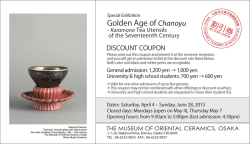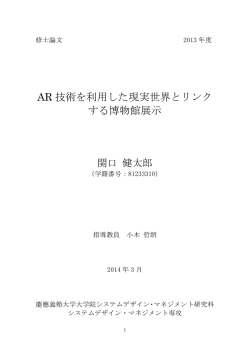
大学院生プロジェクト型研究・研究成果報告書;pdf
教育ネットワークセンター年報, 2015, 15, 149-157(報告|大学院生プロジェクト型研究) 大学院生プロジェクト型研究・研究成果報告書 研究代表者: 渡邊 祐子 (成人継続教育論研究コース) ■研究題目 日本の美術館教育実践における教育意図とその効果に関する研究 ―美術館の専門性と来館者理解を通じて― ■研究代表者・分担者 氏名 渡邊 祐子(成人継続教育論研究コース)(研究代表者) ■研究成果概要(目的、実施内容、結果、今後の課題など) 1.目的 わが国における博物館教育実践の現状を見ると、来館者の要望や世界の潮流をふまえ た、多様な体験学習や展示が全国各地で定着しており、一定の成熟度に達していることが わかる。その一方で、博物館の社会的意義を問う議論は現在もなお継続しており、このこ とから、今日の博物館は教育施設としての機能だけではなく、活動の質が問われているこ とがうかがえる。本研究の目的は、博物館のなかでもとくに美術館を対象として設定し、 美術館内での教育実践によって、どのような学びがどのように生じているのかを明らかに するために、美術館側の理解(教育目的)と、来館者の実際の体験(教育効果)とのあい だに生じる「ずれ」に焦点をあてながら、美術館の学びの文脈を考察することにある。具 体的には、先行する理論的研究をふまえながら、①美術館教育はどのように構成されてい るのか、②それを実践する際どのような専門性が活かされているのか、③それらの「意図 的な教育」は来館者にどのように伝わっている/伝わっていないのかを考察しながら、④ 教育実践の実態と課題を実証する。この研究の独自性は、これまで「社会的」な観点―マ クロな観点から検討されてきた教育普及活動の意義を、実践の構成過程と教育的意図、専 門職員の専門的なはたらき、来館者の内的な変化といった「館や職員」「来館者」の観点 ―ミクロな観点から検討する点にある。 2.実施内容 本研究は、先行研究の検討と並行して、教育的なプロジェクトやプログラムを通じて来 館者に学習の機会を提供する、国内の美術館数館を対象とした実地調査を中心に進められ た。実地調査は、調査対象館の教育担当職員へのオープンエンドのインタビュー、プログ 教育ネットワークセンター年報 第 15 号 ラムへの参与観察によって実施され、美術館においてどのように学びが生じる/生じない のかを、美術館と来館者それぞれの文脈に沿って考察した。 3.結果 調査研究を通じて、美術館における学びが生じるためには、主に三つの要素を考慮する 必要があることが示された。 1) 美術館教育は来館者の自由選択によって動機づけられる。 2) 美術館教育実践は状況や文脈に依存する。 3) 美術館教育と美術館外で獲得した知識や経験に関連が見出されたときに、学びが生じ る。 また、美術館の教育担当職員には、学びの状況と文脈をつくりだす専門性が求められる ことが明らかとなった。 (1) 自由選択学習としての美術館教育 美術館での学びは、人々が生涯にわたって取り組み学ぶことのできる、自由選択の学習 機会としての特徴を性質として持っている。このことは、美術館での学習が、常に学習者 の動機や興味、関心によって形づくられることを示すものである。美術館は、来館者の自 由選択学習の動機が、美術館側の学習意図とほとんど一致しないことを理解しながら、ど のメッセージが重要なものとして取り込まれるかを、教育的な配慮のもと考慮しなければ ならない。先行研究から、学習者は、自分の学習を自分が操作していると感じたときに最 大の効果を発揮するということが示されているが、調査対象館でも、自由選択の美術館教 育の特徴を活かしながら、選択と学習を操作する権限が大いに来館者側に与えられている ことがわかった。 一方で、自由選択の学習であるがゆえに、学習者は特定のプログラムを特定の美術館で 行う意味を見失ったまま活動に参加するケースも見受けられた。参加者自身が、参加して いる美術館でのプログラムの意味を十分に理解できないまま活動が進行した場合、活動固 有の意義や価値を見いだせなくなることもあることが、自由選択学習である美術館教育実 践のむずかしさとして散見した。来館者のニーズや価値を、来館者へのメッセージに置き 換え、来館者に向けて学びを生じさせる機会を提供するためには、美術館教育実践の学習 の状況と文脈を綿密に構成する必要があることが指摘される。 (2) 状況と文脈に依存する美術館教育 自由選択でおこなわれる美術館という教育の場において、学びを発生させるためには、 適切な場面設定やプログラム、メンバーや規模、オブジェクトや道具など、学習状況を生 み出す複数の要素が必要であることが、本調査研究から示された。美術館での学びは、状 −150− 日本の美術館教育実践における教育意図とその効果に関する研究 況や他者に強く影響をうけるものであり、さまざまな要素が相互に作用しあう。このこと は、美術館が、学びが生じる状況をつくりだすために、活動のねらいを自ら認識し、文脈 化し、プログラムのコンテンツとしてあらかじめ組み込むことの重要性を示している。 このような、美術館における場面の設定を考慮した学習は、来館者の学びの異なる動機 や過程に従いながら、それぞれの来館者にとって意味がある要素を浮かび上がらせる過程 となる可能性を示している。一方で、美術館で学びの経験が生じる文脈が、来館者にとっ て読み取れないものであったり、十分に検討されたものでなかったりする場合、来館者の 意味づけのしくみとして機能せず、美術館での経験や行為が意味として立ち現われてこな いことが本調査研究から示された。学習過程が設定や状況に依存するという理解に基づけ ば、来館者の自由選択によって遂行される美術館教育では、なにが来館者に学習を選択さ せる要素となりうるのかを、美術館側が理解することが学びを生じさせるカギとなること が示唆される。 (3) 美術館外の知識や経験とのつながり 美術館は、美術館での学びが来館者の自由選択によるものだと理解したうえで、美術館 側の学習意図と来館者の持ち込む動機が一致しない場合があることを理解しながら、なん らかの学びを生じさせるきっかけを与える役割を担っている。 調査対象館では、プログラムにおける普遍的なねらい(美術館のおもしろさを体験して もらうなど)と特定のプログラムにおける可変的なねらい(ことばによる表現など)が、 どの館の活動においても設定され、学習の文脈を形成していた。この活動のねらいは、教 育実践の文脈に付随して必然的に来館者に掴み取られるようなものではなく、文脈の中で 来館者によって生じさせられるものであるために、来館者がなにを考察し、なにを記憶す るのかに作用する、メッセージ性を含むものであることが求められていた。このメッセー ジ性ある活動のねらいは、ほとんどの館で、美術や来館者同士、職員とのコミュニケーシ ョンを通じて一般化されていたが、とくにそれは、これまでの学びを新たな学びの文脈の なかに移行するときに学びとして認識されていた。普遍的なねらいと可変的なねらいから なるメッセージ性ある活動と、なめらかな学びの文脈が、美術館での教育実践にとくに重 要となるのは、来館者が美術館に持ち込む知識や経験の移行のプロセスを簡単にふむこと ができるように、来館者に働きかける必要があるためである。 4.まとめと今後の課題 本調査研究から、美術館教育実践では、来館者みずからが、美術館教育実践の文脈から、 意味を見出す学習経験を提供することと、意味を構成するきっかけを与えることによっ て、何らかの学びが生じることが考察された。また、美術館での学びは、来館者の新たな 経験や、知識の構成を生じさせる過程を通じて起こるものであり、こうした状況に依存す −151− 教育ネットワークセンター年報 第 15 号 る学習の前提では、美術館教育における来館者の選択の視点や価値を通じた情報の精査に 美術館職員が非常に鋭敏な専門性を発揮していた。 美術館は、大きく視覚や聴覚に関する特化した学習要素を活かした教育を行っている一 方で、人々は、自身が参加する活動の方向性を見失ったり、意義を見失ったりしたときに、 参加への姿勢や集中力に直接的な影響がみられることが考察された。来館者は美術館空間 で方向を見据えて活動に参加することができたときに、目新しい発見を自身と積極的に関 連させていく能動的な姿勢をみせることが示された。 美術館における教育の発生プロセスをおう本調査研究から、教育プログラムも展覧会と 同様に、綿密にデザインされることの重要性が指摘できる。豊かに綿密にデザインされた 美術館教育の経験は、参加者を適切な環境で対象や活動に向き合う集中力をあたえ、実感 をともなう学びとしての学習を誘発するきっかけとして働いていた。この点で、美術館教 育は、生来的に美術館という特定の状況に依存しながらも、美術館とその他の場所の境界 を明確には区別せず、来館者の日常の延長線上に学びの機会を提供するものであるといえ る。これは、美術館での経験から得た理解を、様々な場所から得られる経験や情報から、 長い時間をかけて正確なものにすることを、美術館教育職員が理解しているためである。 このことから、美術館という場所で得られた特定の知識や経験といったあらゆる教育効果 とみなされるものは、そのままでは不完全であり、それは美術館をはなれて外に出たとき に完成するものであるということが指摘できる。美術館での個々人の学びは、自身の経験 からえられた事実と、他の場所で収集した知識や考え方と結びつけられたときに完成する ものであるために、美術館の教育意図も、あらゆる人の人生に活用されるべき性格を有す ることが求められているといえる。美術館を経験した人びとが、見聞きしたものと外の世 界とのあいだにつながりをつくりだし、モノと考えの間につながりをつくりだすことが、 美術館の教育意図であり教育効果であるといえるだろう。そのような意味で、美術館にお ける学びにおいて、最も重要なのは、なにを学んだのかではなく、いかに学ぶかにあり、 美術館は学びの本質を見失わせないために学びの状況を作り出す文脈を、精密さや外的妥 当性をあきらめることなく熟考し続けることが重要であるといえる。 −152− 日本の美術館教育実践における教育意図とその効果に関する研究 Graduate Student Project Type Research Research Report Principal Investigator: Yuko Watanabe (Adult and Continuing Education) ■ Title A study of the educational aims and results of art museum education in Japan: Through the expertise of art museums and an understanding of their visitors ■ Name of the Principal Investigator and Co-Investigator(s) Yuko Watanabe (Adult and Continuing Education) (Principal Investigator) ■ Outline (Research Purpose, Details, Results and Future issues, etc.) 1. Objectives Looking at the current practice of museum education in Japan, we can see that a diversity of experience learning and exhibitions have become established throughout the nation in response to visitor demand and global trends and have reached a certain degree of maturity. Meanwhile, amid the ongoing debate about the social significance of museums, today’s museums seem to be facing questions about the quality of their activities and not just their function as educational institutions. Targeting especially art museums, this study aims to examine the context of art museum learning while focusing on the gap that emerges from educational practices within art museums between the understanding on the side of art museums (educational objectives) and the actual experience of visitors (educational effect). Specifically, based on previous theoretical research, I substantiate (1) what art museum education consists of, (2) the kind of expertise utilized when practicing this education, (3) how this “deliberate education” is conveyed/not conveyed to visitors, and (4) the reality and challenges of educational practices. A unique point about this study is that it examines the significance of education promotion activities, previously examined from a “social” perspective/macro perspective, from a “museum and employee” and “visitor” perspective/micro perspective, that is, the structural process of practice, educational aims, specialized function of curators, and inner change in visitors. −153− 教育ネットワークセンター年報 第 15 号 2. Implementation This study, in parallel with previous research, focused on field research targeting several art museums in Japan that provide museum visitors with the opportunity to learn through educational projects and programs. The field research was conducted in the form of open-ended interviews with the educators of the targeted museums and participant observation of their programs, and the kind of learning that occurs/does not occur in art museums was reviewed in the respective contexts of the art museum and its visitors. 3. Results The survey study showed three main elements that need to be considered for learning to occur in art museums. 1) Visitors are motivated to receive art museum education by their own free choice. 2) Art museums’ educational practices depend on the conditions and context. 3) Learning has occurred when a connection is seen between the art museum education and knowledge and experience gained elsewhere. The survey also revealed that the educators of art museums are required to have the expertise to create the right conditions and context for learning. (1) Art museum education, enabling free-choice learning An intrinsic feature of learning in art museums is that it is an opportunity for people to learn by their own free-choice, enabling them to engage in learning throughout their lives. This shows that learning in art museums is constantly shaped by the motivation and interest of learners. While art museums understand that the motivation of visitors to learn by their own free-choice shows hardly any correspondence with the learning aims of the museums themselves, they need to take into account educational considerations when thinking about what message is taken by them as important. Previous research has shown that learners are most effective when they feel in control of their own learning, and this study showed the museums surveyed in this study largely give the visitors the right to control choice and learning while utilizing the freedom of will as a feature of art museum education. On the other hand, there are also cases of learners taking part in activities on particular programs run by particular art museums whose meaning they have lost sight of because they are learning by their own free-choice. The difficulty of the art museum educational practice of free-choice learning is revealed in some cases by the fact that participants were unable to discover −154− 日本の美術館教育実践における教育意図とその効果に関する研究 the inherent meaning and value of activities when they proceeded without fully understanding the meaning of the museum programs in which they participated. It is pointed out that in order to include the needs and values of visitors within the message to visitors and to provide them with an opportunity that let them really learn, there is a need to carefully organize the learning conditions and context of art museums’ educational practices. (2) Art museum education dependent on conditions and context This study shows that to enable learning at art museums as a free-choice education venue, numerous elements are required to create the right learning conditions such as suitable settings, programs, members, plans, objects and tools. Learning at art museums is greatly influenced by the conditions and other people, and the various elements interact with each other. This shows how important it is for art museums themselves to recognize and contextualize the aims of their activities and to incorporate them in the program beforehand, in order to create conditions that facilitate learning. Such learning taking into account the setting in art museums is also shown to potentially be a process of bringing out the different elements that are meaningful to each visitor while accepting their various learning motivations and processes. At the same time, this study shows that if museum visitors cannot interpret the context producing the learning experience, or it is not sufficiently considered, that context fails to create meaning for the visitors and no significance emerges from their experience or practice in the art museum. Based on the understanding that the learning process depends on the setting and conditions, it is suggested that the key to facilitating learning in free-choice education at art museums is the museums’ awareness of what elements can make visitors choose to learn. (3) Linking to knowledge and experience from outside of art museums The role of art museums is to give visitors the opportunity for any kind of learning, by understanding that learning in art museums depends on visitors having a free choice while also understanding that the museum’s own learning aims do not always match the motives that the visitors bring with them. All of the museums targeted in this study had created a learning context and set up activities with universal aims in their programs (such as having visitors experience the pleasure of art museums) and variable aims in specific programs (such as verbal expressions). These activity aims are not things that visitors naturally grasp within the context of the educational practices but that the visitors themselves have produced within that context, they are required to include messages that affect what visitors think about and remember. The aims of such message-type −155− 教育ネットワークセンター年報 第 15 号 activities is, in nearly all the museums in this study, generalized through communication with art, fellow visitors and staff, but that is particularly perceived as learning when previous learning is transferred into the context of new learning. Message-type activities that have both universal aims and variable aims and a smooth learning context in art museums are particularly important for educational practices because they need to encourage visitors by facilitating the process of transferring the knowledge and experience they bring with them. 4. Conclusions and future challenges From this survey study, I observed that the educational practices of art museums bring about some kind of learning by providing a learning experience that visitors discover for themselves, and by giving them opportunities to form meaning, from the context of those educational practices. Also, learning at art museums is something that occurs through a process of eliciting new experiences and knowledge formation in visitors, and the premise for learning being dependent on such conditions is that museum staff display extremely shrewd expertise in scrutinizing information through the perspectives and values of visitors’ choices in art museum education. Even if art museums conduct education utilizing a lot of video and audio related specialized learning elements, it is observed that when people lost their sense of direction or lost sight of the meaning of the activities in which they were participating, it had a direct effect on their attitude to taking part and their ability to concentrate. It was shown that when visitors were able to see the direction within the space of an art museum and take part in its activities, they showed a positive attitude and associate new discoveries with themselves. This survey study, which seeks to find the process of how education occurs in art museums, points to the importance of carefully designing education programs in the same way as exhibitions. When participants experience an art museum education that has been richly and scrupulously designed, it targets them within a suitable setting and gives them the power to concentrate on activities, serving as a trigger for inducing the kind of learning that comes from reality. On this point, although art museum education depends connaturally on specific conditions of the museums, it seems to provide a learning opportunity as an extension of visitors’ daily lives without clearly distinguishing between the art museum and somewhere else. This is because educators of the art museums have realized that the understanding people have gained from their experience at an art museum turns into something accurate over a long time through experiences and information obtained from various places. This indicates that anything that is considered to be the educational result, such as the specific knowledge and experience, is in fact incomplete, and that the complete result is obtained when it goes outside those museums. Because individual −156− 日本の美術館教育実践における教育意図とその効果に関する研究 people’s learning at art museums is completed when the facts they have acquired from their own experience are connected to knowledge and ideas they have gathered elsewhere, the educational aims of art museums are also required to have a character to be utilized to everyone’s lives. It can be said that the educational aims and educational results of art museums are creating a connection between what people who have experienced those museums have seen and heard and the outside world, and creating a connection between things and ideas. In that sense, the most important thing about learning at art museums is not what is learned but how it is learned, and that art museums continue, while sticking to detail and external validity, to think carefully about the context that will create the conditions for learning in order to keep sight of the essence of that learning. −157−
© Copyright 2024

